Part 7: Folk Dance Fundamentals and Terminology
27 Props
I often find that people especially love dances when they get to play with props! There are a number of common props found in the folk dances of the world. Some are used to make noise, and others are used to create interesting visual effects and others are used to tell stories. In this chapter, we survey some of the most common types of props.
1. Noise Making Props
On the noise making side, we have items that that you strike to make percussive sounds. Tambourines are small frame drums with metallic discs on the side that make a jingling noise when the head of the drum is struck. They also make noise when shaken rather than struck. The primary drum used in Persian and Kurdish dancing is called the daf, which is like a very large tambourine. These are also used as props and musical accompaniment when dancing.
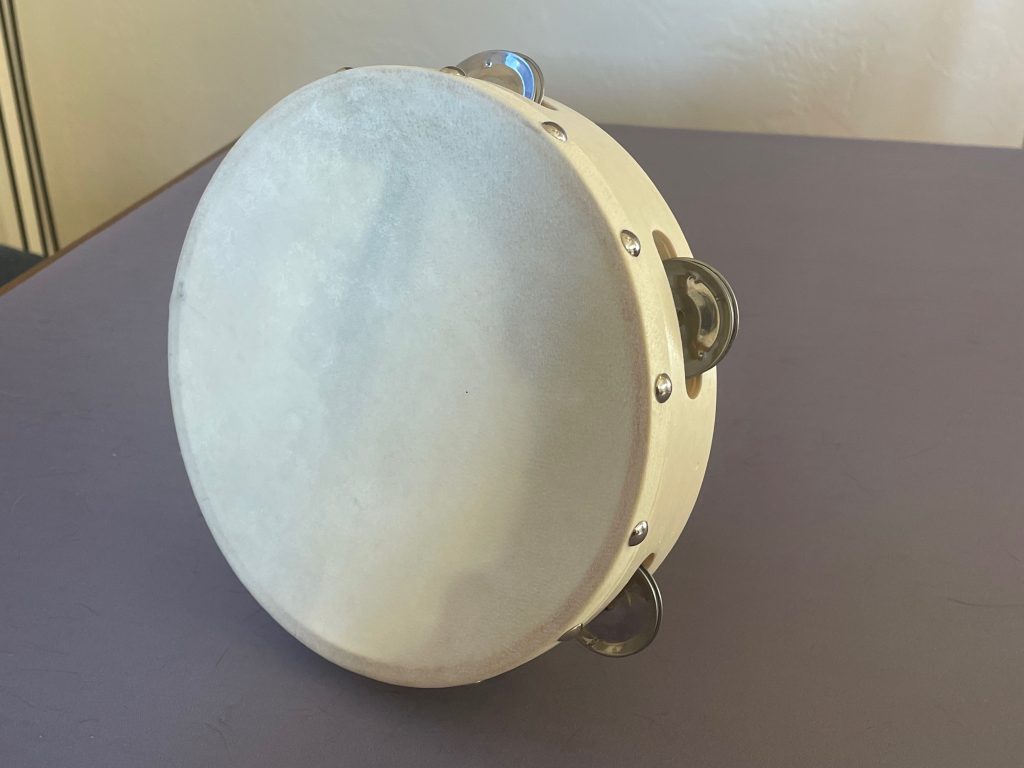
- Video of Italian Tarantella with tambourines: https://youtu.be/7K7zrefNxLo?si=31f4uIQIY_tA8W09
- Persian dance with daf: https://youtu.be/s4dNlDd8u_M?si=Xc8UJQ9MV9Th6bnU
In Macedonian, Bulgarian, and Greek dancing, drums are sometimes used for a completely different purpose. The large tupan drum is used as a prop to stand on to show off the agility and balance of the dancers.
- Bulgarian dancers standing on their tupans: https://youtu.be/YS0FnrVvOT8?si=7–j9pM-Tcb0Nxy7
Leaving Europe and the Middle East for a moment, it’s worth noting that the use of drums as props is common in folk dances around the world. In Hula dancing from Hawai’i, and related dances from the rest of Polynesia, drums serve two functions. They establish the beat, but they are an integral part of the story telling function of the dance. In Hula, these are called Ipu.
- Ipu drums in Hula: https://youtu.be/qBqHxrVgqXc?si=UnGVQ2NJmhr3c_q4
Castanets are frequently found in the dances of Spain and Portugal. They are small cupped wooden discs that are held in each hand hooked by a thread to a finger. As the dancers move and shake their hands, the castanets click against each other. One finds similar clackers in dances of Asia.

- Video of the Spanish Jota done with castanets: https://youtu.be/bAiUYG-aWfM?si=swCVifErbNNOXjEF
In Turkey, the dancers make clicking noises with spoons rather than castanets. Each hand holds a pair of wooden spoons with the convex side of each spoon bowl turned towards each other. One spoon rests — concave side down — in the palm of the hand and the other is held between the two middle fingers. These fingers cause the second spoon to strike the one resting in the palm, causing the clicking noise.
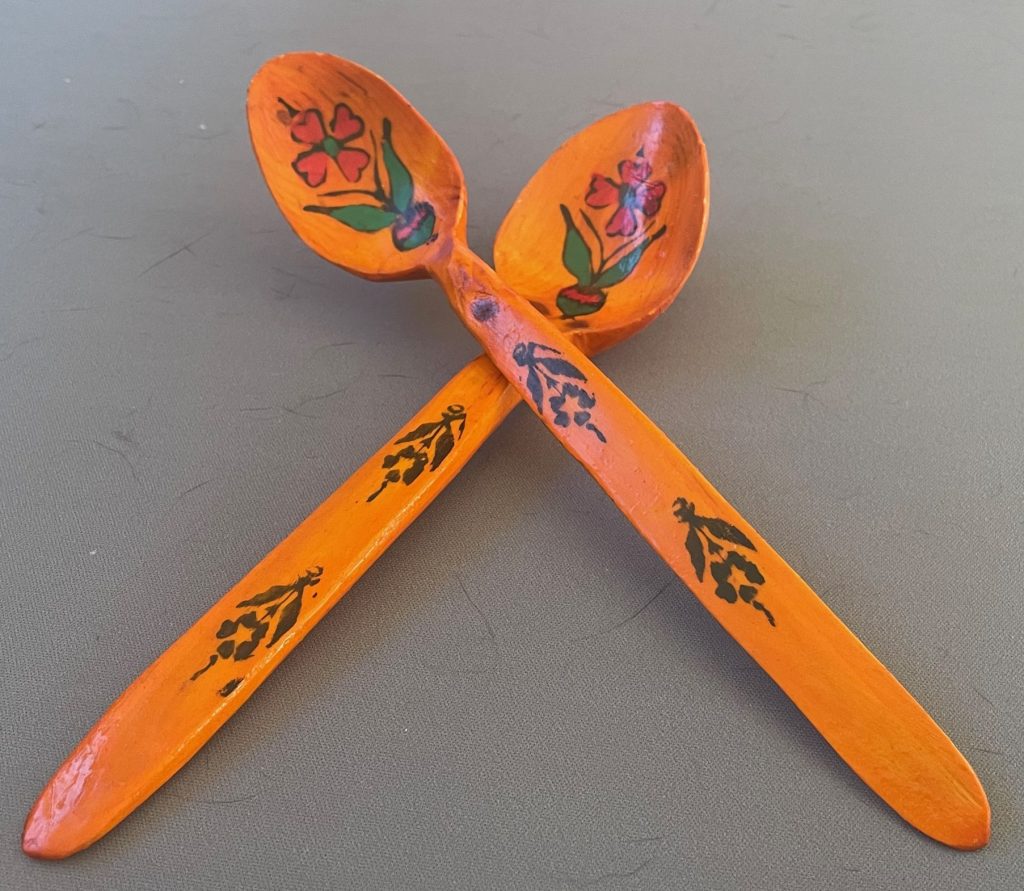
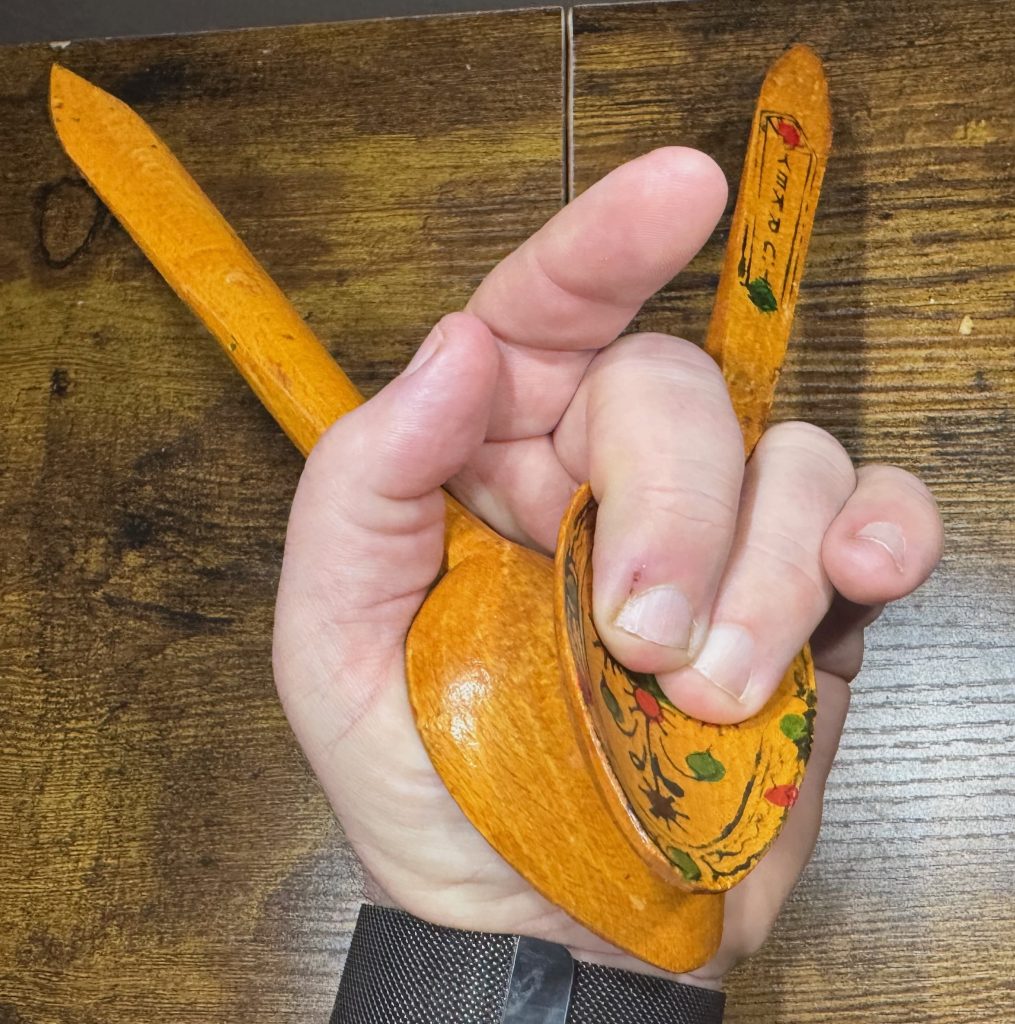
- Video of Turkish Spoon dancing: https://youtu.be/5j7Axt8V1-c?si=Gn9BIwGK7BIAToAz
Closely related to spoons and castanets are the finger cymbals called zils, which are very common in Middle Eastern dancing, particularly in belly dance.
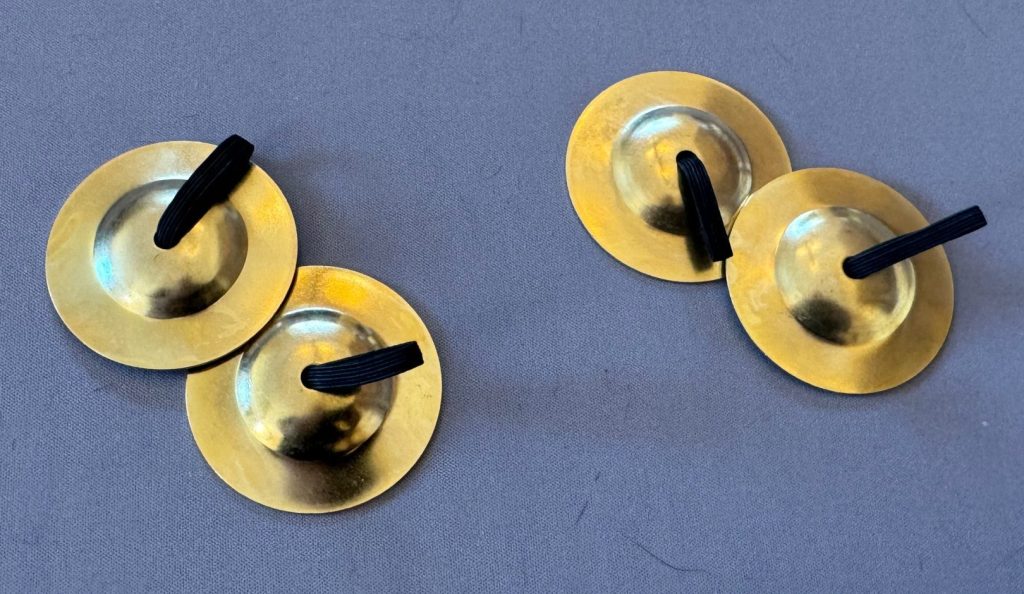
- Video of a belly dance with Zils: https://youtu.be/NNicHZZ0Vdk?si=_ZYhW4OEYLOGXJ0M
Another common prop for making noise by striking are sticks. Sticks are used in Morris dancing from England, but they are also used for Garba & Dandiya dancing in India and in Hula dancing in Hawai’i! Typically, dancers either smack the sticks against the sticks of other dancers or if they are holding two sticks against their own.
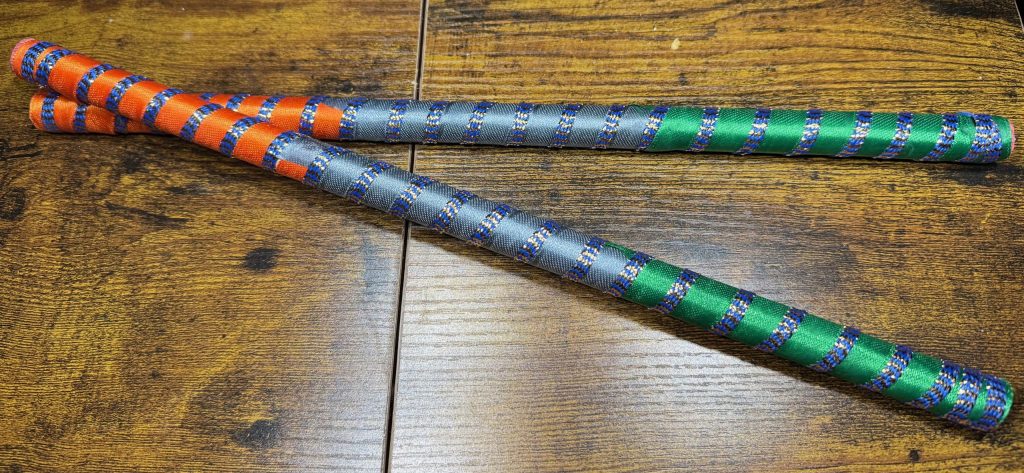
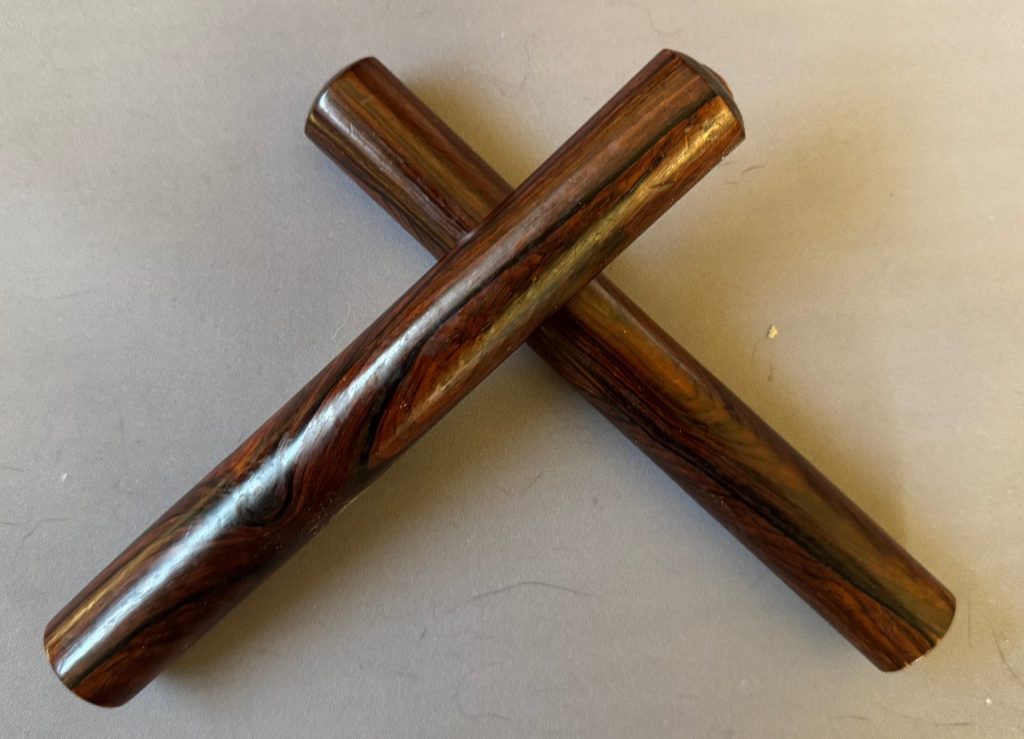
- Video of Morris dancers dancing with sticks: https://youtu.be/ctYuGYwTqZg?si=beMJaHFWT_SQoRMg
- Video of Garba dancing (Dandiya dance from the film Bride and Prejudice): https://youtu.be/Q2PfItSvdxg?si=U7adwzvdlRgDWovT
- Hula Pu’ili Sticks: https://youtu.be/6-LVsP7a5yM?si=ezXrPuhSjj1YB0z1
Perhaps one of the most spectacular usages of sticks are the long poles used in the Philippine dance tinikling. In this dance, two long poles are slapped together and on the ground while the dancers gingerly hop in and out between them without getting their feet crushed. The Călușarii dancers of Romania use medium length sticks but they mostly use them for balance, or to jump over, but they occasionally making noise by banging the end of the stick onto the ground.
- Video of Tinikling: https://youtu.be/_WLfqDMwA_o?si=IMljzUjeVDQeN8XF
- Video of Calusari dancers: https://youtu.be/sImsZJ7cX0o?si=RWSNsBoRffZjjcZU
Another class of noise-making props are things that you shake to make noise. Maracas are an example of such a prop. These are small hollowed out wooden instruments that are filled with beans. Traditionally these were made out of small gourds but are now typically purpose-carved. They make a rattling noise when shaken. They sometimes accompany dances from the Caribbean or Latin America.
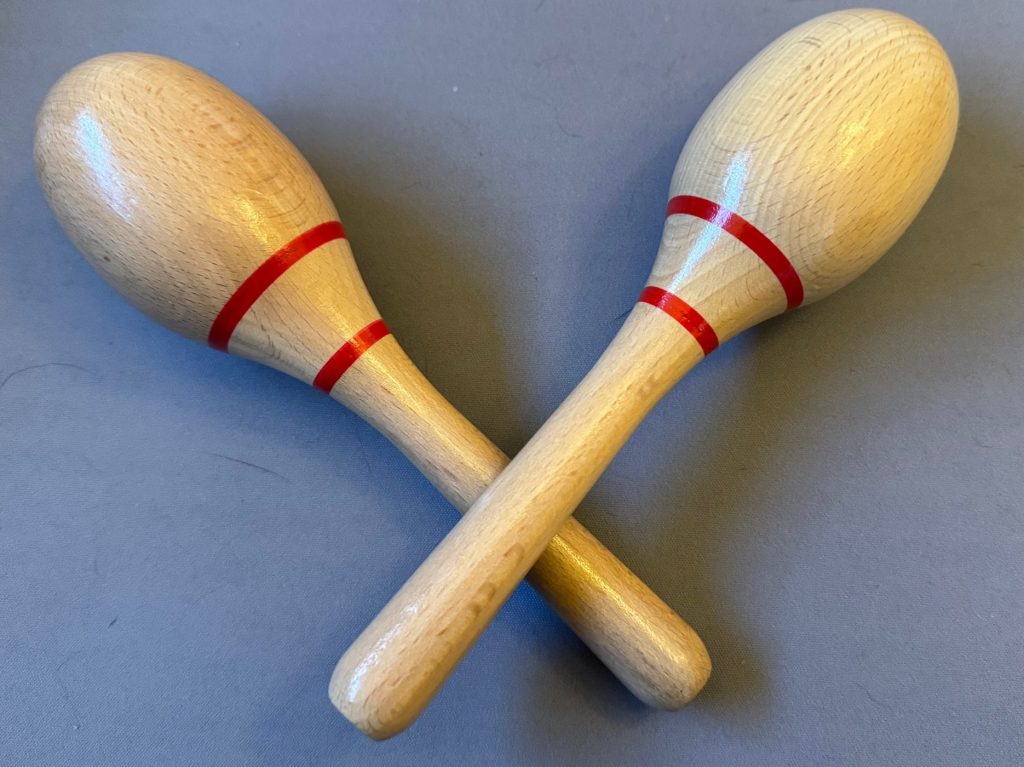
In Hula dancing, there is a shaking rattle called an ‘uli ‘uli. These are made out of gourds with the top covered in brightly colored flowers.
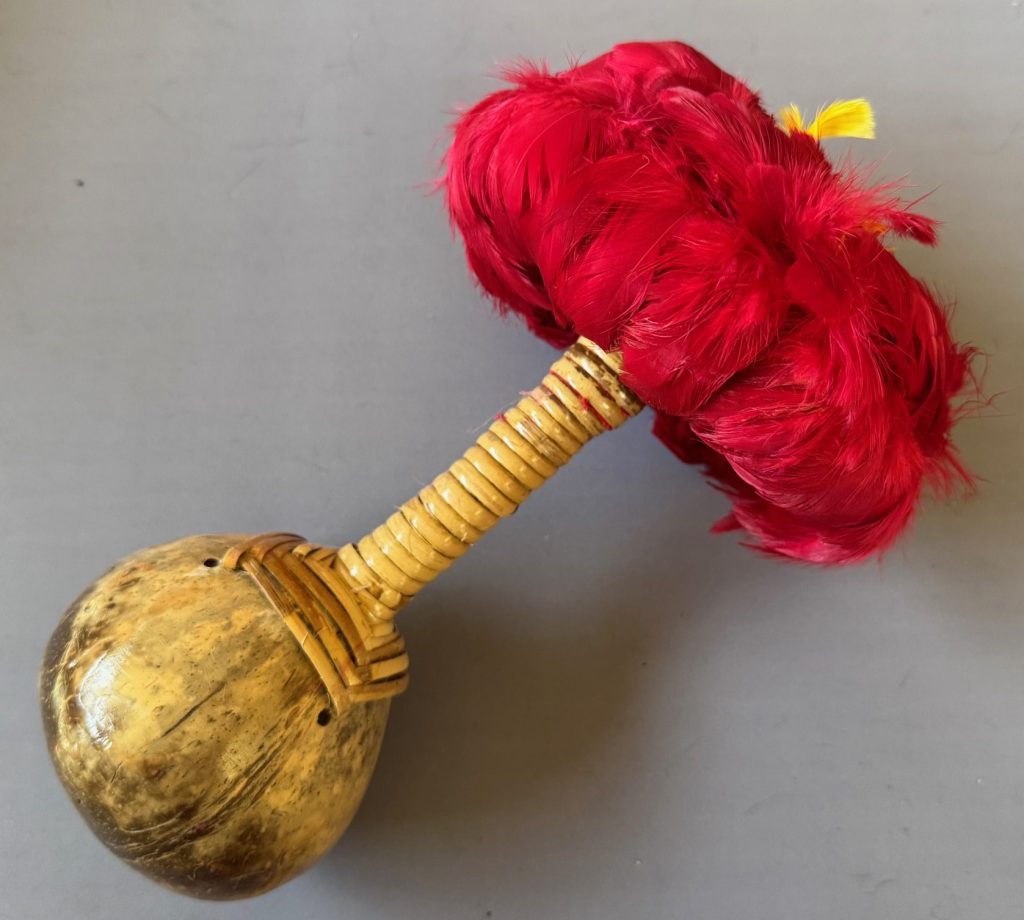
- Video of ‘uli ‘uli rattles in Hula dancing: https://youtu.be/wu8rq_m0rSI?si=G8deITfPTQ90NzaS
Many cultures also make use of bells that make ringing noises as you shake them. These might be wrapped around the wrist as in Chinese dances. Or they may be sewn to straps that are wrapped around the shins or ankles. Such noise making bells are called Ghungroo in India, but they are also found in Morris dancing and related traditions.
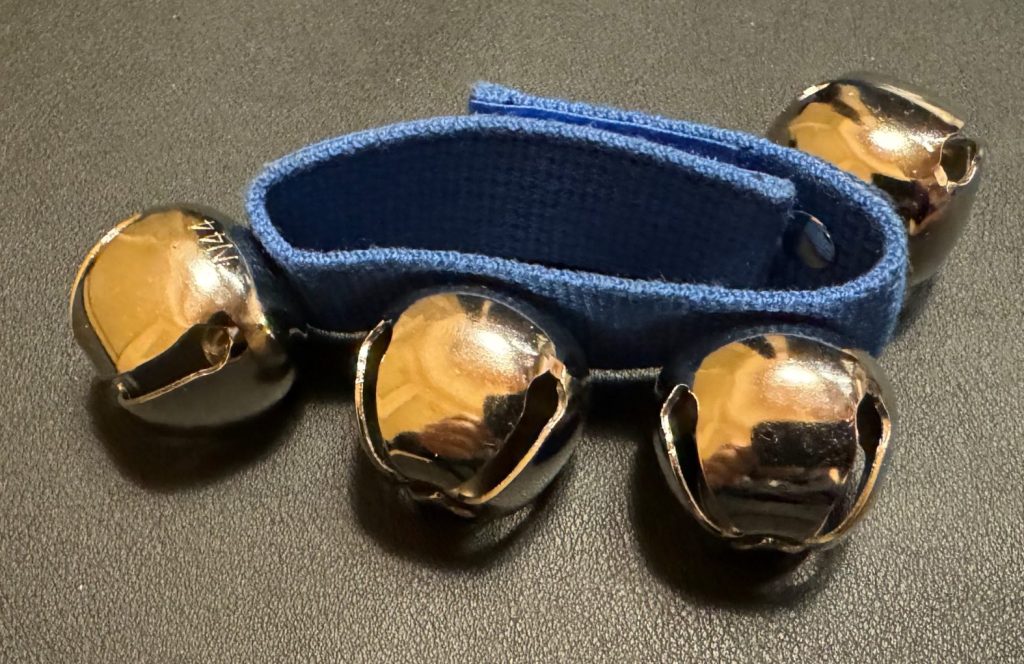
Much larger cow bells are also found, for example in traditions as widely spread out as the Kukuri of Bulgaria, Krampus dancers in Germanic countries, and the Joaldunak dancers of the Basque people of Spain.
- Joaldunak dancing with large cow bells: https://youtu.be/XcPTiKbpdRc?si=uoLohMbrC_XiTeBx
- Morris dancing with shin-bells: https://youtu.be/fizQRqVUW0s?si=wW8MWSGcFR3BV9y_
2. Props for Visual Impact
Some props are present solely for visual impact rather than to make noise. These can be, frankly, every and kind of object that a community might use in everyday life but ritualize for dance. Some common examples are hoops, garlands, fans, scarves, ribbons, candles, flags, banners, sheets, canopies, brooms, benches, logs, saws and axes. The Basques have a very unique prop that comes from their agricultural practices: stilts! It’s thought that they wore stilts so they could keep an eye on their sheep. Other hypotheses are that they wore them to gather fruit from high vines and trees. In any case, they’ve converted them over to a prop for dancing!
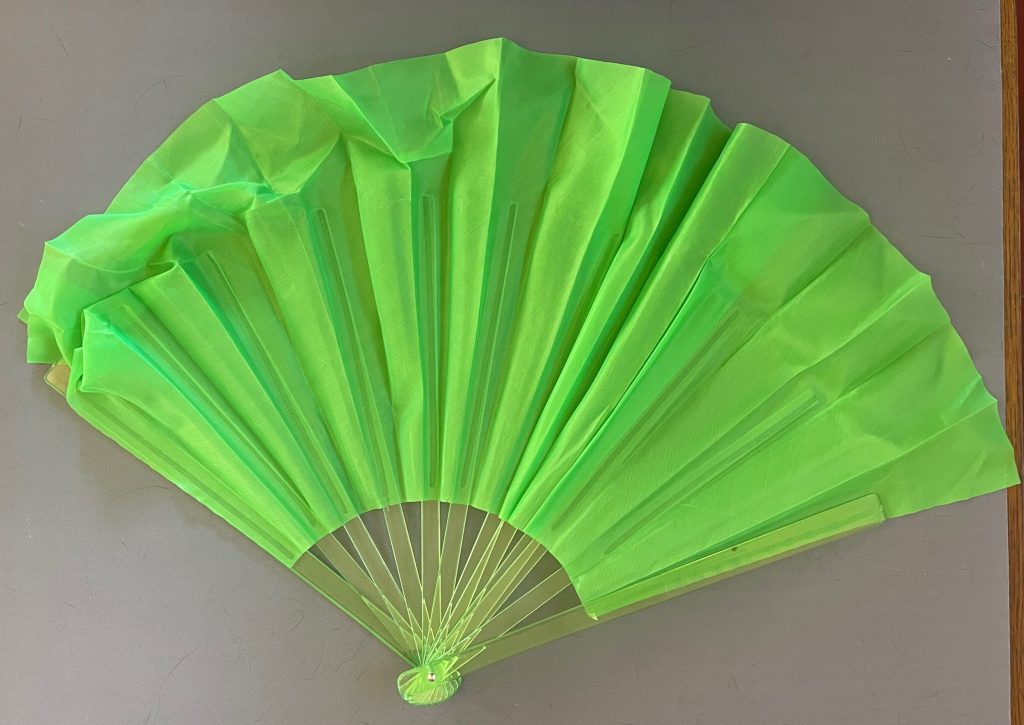
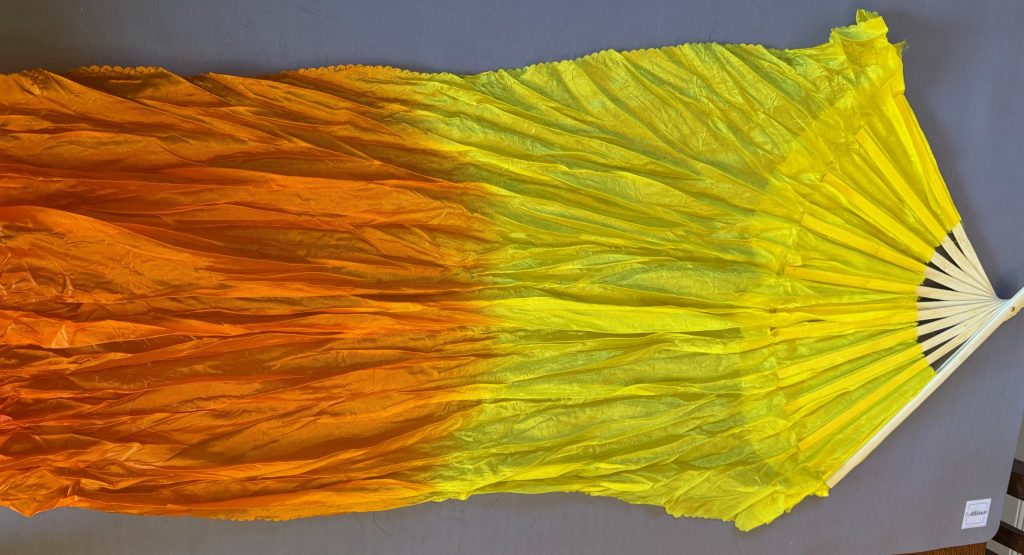
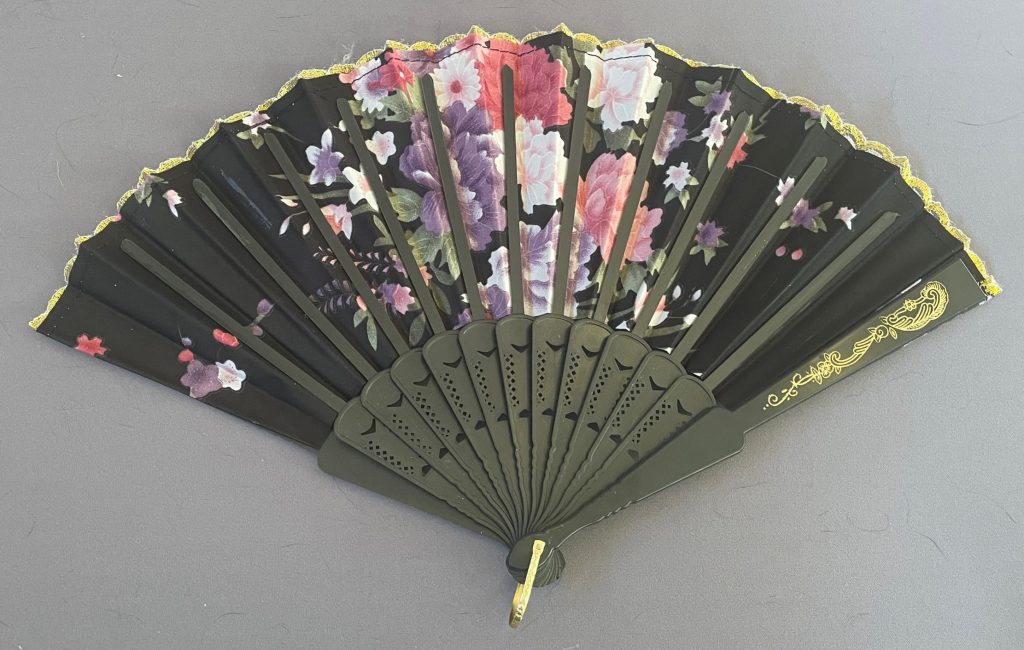
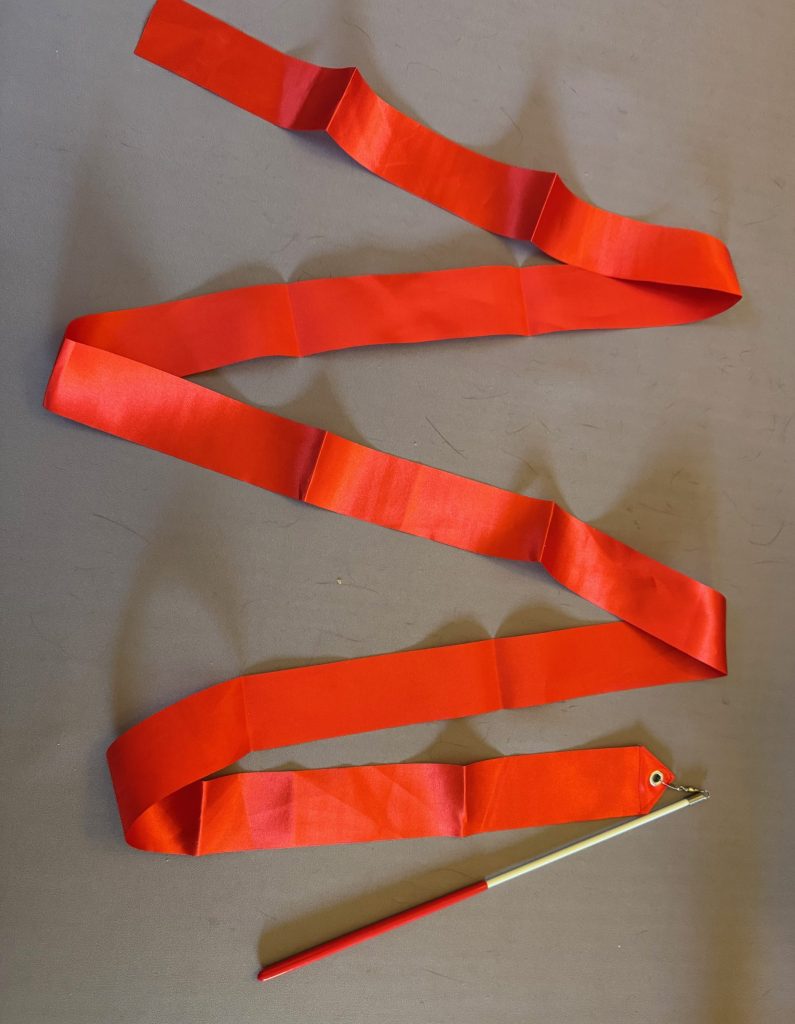
- Pow wow hoop dancing: https://youtu.be/uRKWBoLcIaQ?si=8UpwV0pZ9H0Tt2JU
- Hochzeitstanz garland dance: https://youtu.be/zS876kXAHyg?si=o6i2q4mv_enfCem3
- Korean fan dance: https://youtu.be/XTMSP65s4LY?si=gHh5TPItO8GIH28U
- Chinese fan dance: https://youtu.be/XlQsVY3z4TI?si=Noet4Y6WTivgrxa-
- Chinese long fan dance: https://youtu.be/Gk69_lzsMVk?si=OOtlcKCjJ9hDT6Nb
- Chinese ribbon dance: https://youtu.be/bBX5GU1S2Sg?si=O4W5DB_KHrswrsQS
- Vera Cruz Mexico, ribbon dance: https://youtu.be/dq7bJ-xP2EE?si=4fh3xv2ajjtm8v5H
- Armenian canopy dance: https://youtu.be/W4SsR1gwP8I?si=CaTMFpnk-UrUf4Tg
- Philippine flag dance: https://youtu.be/z50cPteLqmU?si=9sHYvLd32H9GZlEV
- German witches broom dance: https://youtu.be/BjUV-byB8ls?si=2R7mJ7F6f68p7TWd
- Irish broom dance: https://youtu.be/oB7tZ5904NM?si=tLhf4SX8oEr_bx8d
- Métis broom dance: https://youtu.be/4UgwRj-JDSk?si=o9__fdlkJdLWGyeo
- Holzhackertanz (logs & saws & axes): https://youtu.be/eSbYSNzyiOg?si=wKyR2RlGyM7n5-Vl
- Bankltanz (benches): https://youtu.be/aBNNhaE3oTY?si=qETfntTrgAFnLxGp
- La Bruja from Mexico (candles): https://youtu.be/2Z8HzF0_KTc?si=u50uhcWwC6mnEHI3
- Gyovand from Armenia (candles): https://youtu.be/cpjvyDnBRjU?si=hPzl0_6b7oHemJ3q
- Mom Bar from Albania (candles): https://youtu.be/HSjr9BmhPhA?si=zW8cJP6dTJR8LC6_
- Pandanggo from Philippines (candles): https://youtu.be/4Gf8Xa0N2yk?si=6uYJmxf49dk7P1rm
- Basque stilt dancing: https://youtu.be/fBxSeV0ZGMw?si=ZYpDC27UGjR_XkrH
Other props may actually be extensions of the costume but are used for particular visual effect. In El Jarabe Tapatio — more commonly known as the Mexican Hat dance — the dancers dance around the man’s wide brimmed sombrero. Extra-long sleeves are used for effect in both Korean traditional dance and dances of the Caucasus; they are used much like scarves to highlight the motion of the arms. In Georgia, one also finds women’s long skirts and men’s long cloaks being used to give the illusion that the dancers are floating or skating. Mexican women swish their large skirts for stunning visual effect. Sometimes shawls are used the same way, as in flamenco dancing.
- El Jarabe Tapetio (Mexican Hat Dance): https://youtu.be/0CRSIjT0sYY?si=HCL698ozKHGvkU76
- Jalisco dance with swinging skirts: https://youtu.be/s7rtYppWdRA?si=ely4qtbUAXBOxoDq
- Korean Sleeve dance: https://youtu.be/CVhZPUMPxMQ?si=oO4fJOr67CnrJBBN
- Georgian long sleeve: https://youtu.be/Nl9uWRu0fo4?si=vBoctu0KhyS_It0W
- Georgian shawl dance: https://youtu.be/3xcZHA8mFgc?si=MHMp73aeequbPEeA
- Georgian cloak dance: https://youtu.be/U2Ly_lsdHn8?si=9OX3gx6WY97HgKrc
- Flamenco manton (shawl) dance: https://youtu.be/_gb6Z9XZlSI?si=tJp11aY7XjOP3vzm
In other cultures, sticks, canes, swords and even rifles are used as props to simulate martial events. Canes are particularly common in belly dance or in folk dances from the Arabic Peninsula. The canes are sometimes replaced by daggers, rifles and swords.
- Cane dance from Dubai: https://youtu.be/IXmUKfEy5pw?si=yNjClHXSK5vissgu
- Arabic sword dance: https://youtu.be/6kKWtiNowB0?si=FI81ntKnEPJ8r6rj
- Omani dance with daggers: https://youtu.be/87h_TNLHRGY?si=YM_BMOe4AJU1tp1o
- Emirati Al Youlah Rifle dance (رقص اليولة): https://youtu.be/S9YboY-fx7A?si=Rh1we1sQ7vd_l5Va
- Saudi gun jumping dance: https://youtu.be/AI9qRmWCEJw?si=_vWGU9uHVZaAl4R2
- Persian knife dance: https://youtu.be/ZiGSNmKKsvY?si=56vpwvvl4ds6rnzb
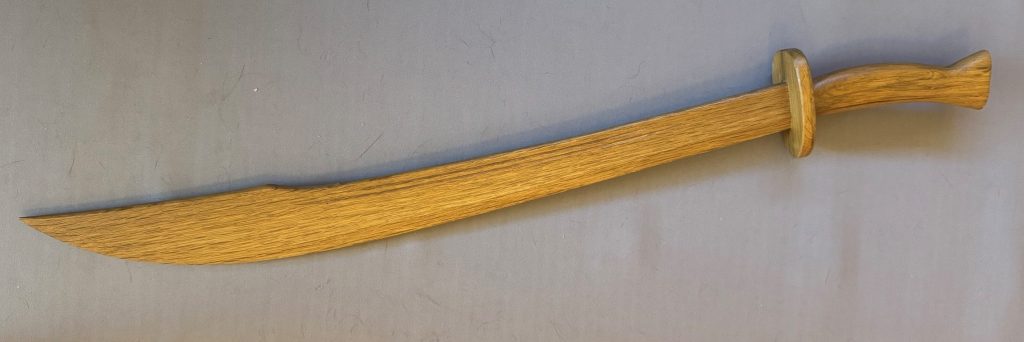
Sword dances are found in many other parts of the world too. When you say “sword dance” many people think of the Highland sword dance, which is done to the tune Gillie Calum. Rather than holding the sword, Highland dancers do intricate steps over crossed swords on the ground. Long sword dances are also found in England, where dancers hold the hilt of the sword in one hand and the tip of their neighbor’s sword in the other, then they dance intricate weaving steps over and under the swords. The tradition of rapper dancing is clearly related. Rapper swords (not to be confused with rapiers!) are short very flexible pieces of metal with a handle on each end. Like longsword dancing, the rapper dancers weave in and out while holding onto the swords. This is also accompanied by acrobatic flips and jumps over the swords. The Georgians and other people of the Caucasus do both solo dances showing off their swordsmanship and dances where they simulate battles during the dance.
- Scottish Highland sword dance: https://youtu.be/vP4N33dZLM0?si=KaSIpbf7HiHMRb3q
- Yorkshire Longsword dance: https://youtu.be/Jk8wtdD_5fM?si=SXG-brW0tHwO35Cj
- Rapper dancing (Candyrapper VSOC): https://youtu.be/74hFA7-xryY?si=SgUwhmnePr2K–IS
- Solo Sword dancing from the Caucasus: https://youtu.be/W3i7K8Ep7Lw?si=klNTjElfNIxQayNp
- Georgian sword dancing simulating battle: https://youtu.be/8OsAsJejxJY?si=o-iLQP9EJ3AqqRMC
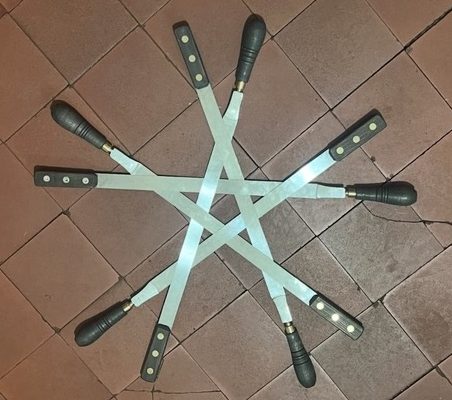
Another interesting prop that might have a martial origin is the poi balls that started with the Māori in New Zealand but are now common in many different styles of Polynesian dance. Their origin is a bit obscure, but they may have originated as weapons. A related tradition is the Polynesian fire-knife tradition, which is done by male dancers who juggle a stick with fire on both ends. Another fire related dance tradition are fire walking dances like the Nestinarsko dance from Bulgaria.
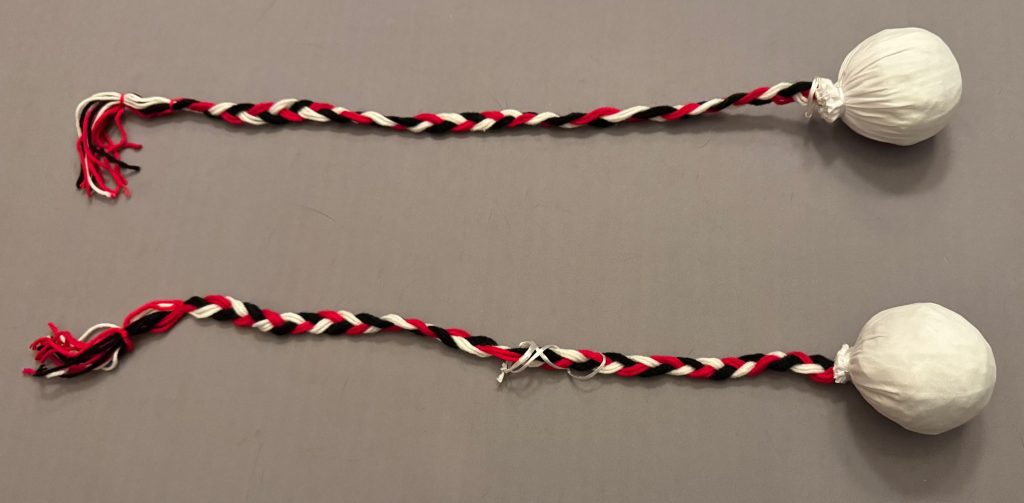
- Poi Ball dancing: https://youtu.be/Gt35JAg3aXo?si=y730nSrRa2o-ekBG
- Polynesian fire knife dancing: https://youtu.be/esDzXOkuX4k?si=qwywRIqwRF9QAKGR
- Nestinarsko (Bulgarian firewalking dance): https://youtu.be/o1JZciu0kc0?si=T1Tai0fFH1JGT1j5
3. Story Telling Costumes and Props
In chapter 6, on the dances of Mexico, Central America and the Caribbean, we talked about dance-dramas that act out parts of the bible or the conquest of the Americas. In those dances the costumes and props are critical to the narrative structure of the dances. But costumes are props are critical to story-telling dances from other cultures too. In Eastern Europe there is a dance tradition where a wedding opens with a ceremony, with the couple’s parents welcoming the bride and groom with a gift of bread and salt, which is meant to be symbolic of the ways they wish the couple to prosper and to warn them about the challenges of married life. The ceremony is typically accompanied by specific songs and dances. Other story telling dances with props and specific costumes are related to religious rituals or specific times of the year or to superstitions. There is a tradition in Bulgaria for example, that people in grotesque monster costumes called Kukuri dance through the streets at New Years and at Lent to scare away evil spirits. The Krampus tradition in Germanic countries that happens at Christmas seems to have similar origins, although Krampus is now associated with punishing bad children. In Romania, there are several different traditions of dancing in grotesque costumes, sometimes as goats, deer or bears and sometimes as deformed old people. Some of these may be associated with successful hunts, or growing old and prosperous, and others with scaring away spirits. All of these traditions of dressing up in scary costumes at key celebration times may well be pre-Christian. There are other European dances that may well be pagan in origin. For example, in England, there is still a tradition in some places of doing “horn” dances, where the dancers carry the skulls and horns of stags and pretend to be deer; this could well be a holdover of an ancient religious rite.
- Ukrainian bread and salt dance: https://youtu.be/zIKr0GWI7UM?si=IcxDyJNpakjklshS
- Jocul Caprelor și a cerbului (Romanian goat dance) https://youtu.be/NEhSuV2vq60?si=NdA3NaoFxind940b
- Romanian Goat dance: https://youtu.be/Q7oeO1yuFSU?si=DQCRUU9k0ZODFcU7
- Jocul Mosilor (Romanian old person costumes): https://youtu.be/FnEq8DArn2Q?si=AXWl38sUGWiV2xUZ
- Jocul Măștilor: https://youtu.be/LuikEw_tFfo?si=Gd_-fE7ktXdV1v-4
- Jocul Mascaților: https://youtu.be/9aIOj83PVY4?si=cL_2nNsbrdn9CXWa
- Romanian Bear (Ursul) dancers: https://youtu.be/Uh_PJEA-v2M?si=gGziZQS3xlolv_IS
- Bulgarian Kukuri: https://youtu.be/8lxB4CGVecM?si=cyIoIlBw4k0q8PKx
- Abbots Bromley Horn dance: https://youtu.be/tk6YkT8XBmY?si=sQ15rOnWZzUcY2-s
Masked story telling or ritual dances are found throughout the world, with examples being found in China (e.g. the famous Chinese Lion and Dragon dances), Noh dances from Japan, masked dance plays from Tibet, the deer dances of the Hiaki people and more.
- Chinese Lion dance: https://youtu.be/n-0DJzxUdTE?si=BDh1cs1zMbt_CGzI
- Chinese Dragon dance: https://youtu.be/vi95ZTEHoL8?si=FWMbyxuQfAA5eD_1
- Tibetan Masked dance: https://youtu.be/UhvhflRLXpU?si=OiD0BiJqHmIZ__um
- Hiaki deer dancing: https://youtu.be/eghZreYRNPU?si=vx3c08iORNUHlzZi
Further Reading and Online Resources
- https://folkdancemusings.blogspot.com/2019/11/bankltanz-germany.html
- https://folkdancemusings.blogspot.com/2015/01/hochzeitstanz-germany.html
- http://cscanada.net/index.php/ccc/article/view/6661
- https://www.danceproject.com.mt/2023/10/29/props-in-dance/
- https://www.rowenagander.com/2021/02/role-and-function-of-props-in-dance/
- https://www.flamencoschool.ca/flamenco-elements/
- https://sites.psu.edu/amongiapassionblog/2020/02/21/more-instruments-the-props-the-dancers-use/
Discussion Questions
Discussion Question 1
Do you think that dances with props are an unnecessary challenge for recreational dancers, or do they enrich the experience for participants?
Discussion Question 2
A lot of dances with props and elaborate costumes are performed on the stage rather than in community settings. While they are clearly tied to specific ethnicities, discuss whether they represent “folk dance” in the different senses discussed in chapter 1.
Media Attributions
- Figure 27.1: A tambourine © Andrew Carnie, personal collection is licensed under a CC BY-NC-SA (Attribution NonCommercial ShareAlike) license
- Figure 27.2: Castanets © Andrew Carnie, personal collection is licensed under a CC BY-NC-SA (Attribution NonCommercial ShareAlike) license
- Figure 27.3: Turkish Spoons © Andrew Carnie, personal collection is licensed under a CC BY-NC-SA (Attribution NonCommercial ShareAlike) license
- Figure 27.4: Hand position for Turkish spoons © Andrew Carnie, personal collection is licensed under a CC BY-NC-SA (Attribution NonCommercial ShareAlike) license
- Figure 27.5: Zils © Andrew Carnie, personal collection is licensed under a CC BY-NC-SA (Attribution NonCommercial ShareAlike) license
- Figure 27.6: Garba/Dandiya sticks © Andrew Carnie, personal collection is licensed under a CC BY-NC-SA (Attribution NonCommercial ShareAlike) license
- Figure 27.7: Rosewood claves from Mexico © Andrew Carnie is licensed under a CC BY-NC-SA (Attribution NonCommercial ShareAlike) license
- Figure 27.8. Maracas © Andrew Carnie, personal collection is licensed under a CC BY-NC-SA (Attribution NonCommercial ShareAlike) license
- Figure 27.9: ‘uli ‘uli © Andrew Carnie, personal collection is licensed under a CC BY-NC-SA (Attribution NonCommercial ShareAlike) license
- Figure 27.10: Taiwanese wrist bells © Andrew Andrew Carnie, personal collection is licensed under a CC BY-NC-SA (Attribution NonCommercial ShareAlike) license
- Figure 27.11: Chinese dance fan © Andrew Carnie, personal collection is licensed under a CC BY-NC-SA (Attribution NonCommercial ShareAlike) license
- Figure 27.12: Long Chinese fan © Andrew Carnie, personal collection is licensed under a CC BY-NC-SA (Attribution NonCommercial ShareAlike) license
- Figure 27.13: French/Caribbean fan © Andrew Carnie, personal collection is licensed under a CC BY-NC-SA (Attribution NonCommercial ShareAlike) license
- Figure 27.14: Chinese ribbons © Andrew Carnie, personal collection is licensed under a CC BY-NC-SA (Attribution NonCommercial ShareAlike) license
- Figure 27.15: Belly Dance Sword Prop © Andrew Carnie, personal collection is licensed under a CC BY-NC-SA (Attribution NonCommercial ShareAlike) license
- Figure 27.16: Rapper swords in a traditional lock formation © Sam Overbeck, used with permission
- Figure 27.17: Poi Balls © Andrew Carnie, personal collection is licensed under a CC BY-NC-SA (Attribution NonCommercial ShareAlike) license

